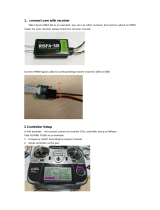
Timer Settings .......................................................................................................................... 4-10
SNMP Trap Server...................................................................................................................... 4-11
E-Mail Server ............................................................................................................................ 4-11
Active Message Server ............................................................................................................... 4-13
SMS Phone Book ....................................................................................................................... 4-13
Working/Off Working Days .......................................................................................................... 4-14
FTP Settings ............................................................................................................................. 4-14
Data Logging Profile List ............................................................................................................. 4-15
Internal Register (Float) Settings................................................................................................. 4-17
Working with Logic ........................................................................................................................... 4-18
Click&Go Logic Basics ................................................................................................................ 4-18
IF Conditions ............................................................................................................................ 4-20
More Information about Repeat Interval vs. Edge Detection ............................................................ 4-25
THEN/ELSE Actions .................................................................................................................... 4-27
Activating the Rule-set ...................................................................................................................... 4-37
Upload, Restart, and Run ........................................................................................................... 4-37
Rule-set Management Bar .......................................................................................................... 4-37
Import/Export Configuration .............................................................................................................. 4-37
5. Planning and Assistance.................................................................................................................... 5-1
Known Issues of Cellular Monitoring Systems ......................................................................................... 5-2
Configuring a Static IP Address for Active OPC Server ............................................................................. 5-3
Cellular Micro Controller Architecture..................................................................................................... 5-4
Using ioAdmin to Perform Simple Data Monitoring from a Remote Site ...................................................... 5-5
Expanding Input/Output Channels ........................................................................................................ 5-7
Using Modbus/TCP Protocol with Your Program ....................................................................................... 5-9
Using Counter to Get Meter Readings and Statistics .............................................................................. 5-11
Record your I/O Data in the Data Log File ............................................................................................ 5-13
Connecting a Modbus/RTU Serial Device Attached to the ioLogik over a Cellular Network ........................... 5-19
Connecting to a SCADA System .......................................................................................................... 5-19
Updating Serial Tags to SCADA System with Active OPC Server over a Cellular Network ............................ 5-21
Handling Front-End Events and Alarms ................................................................................................ 5-23
SMS Escalation and Acknowledgement ................................................................................................ 5-24
SMS Commands for Monitoring and Control ......................................................................................... 5-27
Enabling the Power Saving Function and Secure Wake on Call ................................................................ 5-28
Enabling Ethernet and Cellular Redundancy.......................................................................................... 5-29
A. Pin-outs and Cable Wiring ................................................................................................................. A-1
Pinouts .............................................................................................................................................. A-2
CN1: SMA, Cellular Antenna Connector .......................................................................................... A-2
CN2: DB9, Male, RS-232 Connector ............................................................................................... A-2
CN3: RJ-45, Ethernet Connector.................................................................................................... A-2
TB1: Power Input Terminal Block ................................................................................................... A-3
TB2: I/O Terminal Block (W5340) .................................................................................................. A-3
TB3: 5-pin, 4-wire/2-wire RS-422/485 Terminal Block...................................................................... A-3
TB2: I/O Terminal Block (W5312) .................................................................................................. A-4
Cable Wiring ...................................................................................................................................... A-4
Digital Input Dry Contact .............................................................................................................. A-4
Digital Input Wet Contact ............................................................................................................. A-4
Digital Output Sink Mode .............................................................................................................. A-5
Relay Output .............................................................................................................................. A-5
Analog Input ............................................................................................................................... A-5
B. SMS Commands ................................................................................................................................. B-1
SMS Command Syntax: ....................................................................................................................... B-2
SMS Command Table .......................................................................................................................... B-2
C. Modbus/TCP Address Mappings ........................................................................................................ C-1
ioLogik W5340 and ioLogik W5340 HSDPA Modbus Mapping ..................................................................... C-2
0xxxx Read/Write Coils (support functions 1, 5, 15) ........................................................................ C-2
1xxxx Read only Coils (supports function 2) ................................................................................... C-6
3xxxx Read only Registers (supports function 4) ............................................................................. C-7
4xxxx Read/Write Registers (supports functions 3, 6, 16) ................................................................. C-7
5xxxx Write Registers (supports function 8) .................................................................................. C-18
ioLogik W5312 Modbus Mapping ......................................................................................................... C-18
0xxxx Read/Write Coils (supports functions 1, 5, 15) ..................................................................... C-18
1xxxx Read only Coils (supports function 2) ................................................................................. C-23
3xxxx Read only Registers (supports function 4) ........................................................................... C-23
4xxxx Read/Write Registers (supports functions 3, 6, 16) ............................................................... C-25
5xxxx Write Registers (supports function 8) .................................................................................. C-37
D. SNMP Agents with MIB II, RS-232-like Groups ................................................................................. D-1
E. Factory Default Settings .................................................................................................................... E-1
F. Troubleshooting the Cellular I/O Connection .................................................................................... F-1
























